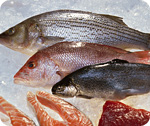ust when you thought eating fish was iffy enough due to Fukushima radiation, the gulf oil spill, mercury and other toxins found in fish, one of the largest seafood fraud investigations in the world to date has found that 59 percent of the tuna Americans consume is not really tuna. Worse still, most of the fake tuna was found to actually be a fish known for causing gastrointestinal problems.
The non-profit ocean protection group Oceana collected more than 1,200 samples from 674 retail outlets in 21 states from 2010 to 2012 to determine if they were honestly labeled. DNA testing found that one-third of the 1,215 seafood samples were mislabeled, according to U.S. Food and Drug Administration (FDA) guidelines.
The fish Oceana found to be most often mislabeled was red snapper, where 87 percent of the samples collected were actually one of several other varieties of fish – such as perch and tilapia. Perhaps the most disturbing finding was that 84 percent of the fake fish substituted for second place tuna was escolar – a fish which can cause explosive, oily, and orange diarrhea.
Escolar, often mistakenly labeled in raw form as a variety of tuna called “butterfish,” is a type of snake mackerel that is unable to metabolize the wax esters called gemplyotoxin which are naturally found in its diet. The esters are called gempylotoxin, and are very similar to castor oil or mineral oil and the esters are what gives escolar an oily texture similar to tuna. As a result of the esters, eating full portions of escolar can cause severe gastrointestinal problems.
The fraudulently labeled seafood was found at sushi bars, restaurants and grocery stores with sushi bars being found to be far more likely to have the mislabeled fish. Oceana did not find a single sushi bar which had no dishonestly labeled fish.
Though the Oceana investigation did not determine where the fraud occurred in the chain from ocean to consumer, the reasons for the labeling fraud are obvious: greed and availability.
In practically every instance of mislabeling, a cheaper variety of fish was substituted for a more expensive one. Often, price differences are due to availability. Red snapper supplies, for example, are very limited as the levels of the popular fish have been severely depleted far beyond demand. Likewise, popular varieties of tuna, including albacore, yellowfin and bigeye, have been significantly depleted from over-fishing. Even the most common type of tuna, skipjack, may soon be in danger due to increased fishing pressure.
Other highlights of the Oceana investigation:
• Mislabeling was found in 27 of the 46 fish types tested (59 percent)
• Salmon, snapper, cod, tuna, sole, halibut and grouper were the top collected fish types
• Only seven of the 120 red snapper samples were honestly labeled
• Between one-fifth to more than one-third of the halibut, grouper, cod and Chilean sea bass samples were mislabeled
• 44 percent of all the grocery stores, restaurants and sushi venues visited sold mislabeled seafood
Today, more than 90 percent of the seafood consumed in the U.S. is imported, and fewer than one percent is inspected specifically for fraud by the government.
Seafood is a popular, and theoretically healthy, food choice for many Americans. Both the American Heart Association and new dietary guidelines from the FDA recommend eating eight ounces of seafood, or two seafood meals, a week. Seafood is a global commodity and is one of the most commonly traded food items in the world.
As the Oceana investigation has revealed, it is also one of the most common food items likely to be used to defraud consumers.
Sources:
http://www.theatlantic.com
http://oceana.org
http://wwf.panda.org
http://oceana.org
http://www.tbyil.com/Mercury_Heavy_Metals_in_Fish.htm
http://www.thekitchn.com/use-caution-when-eating-escola-66602


